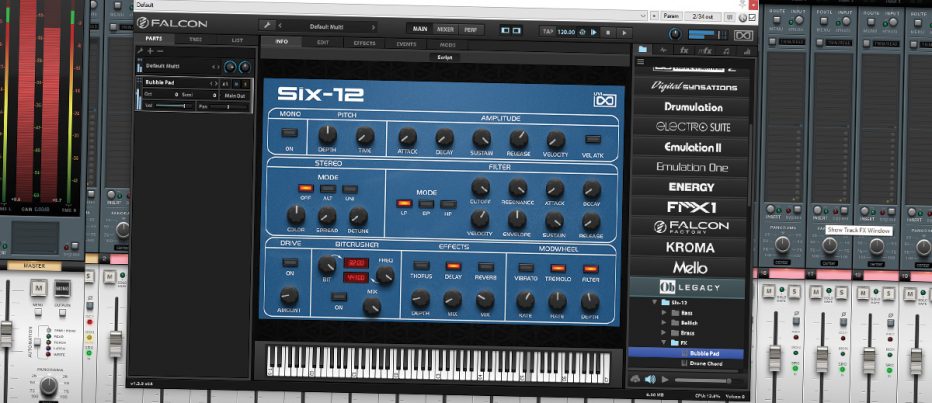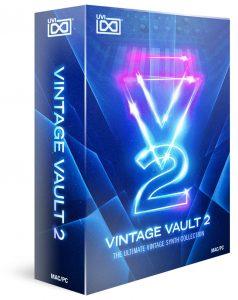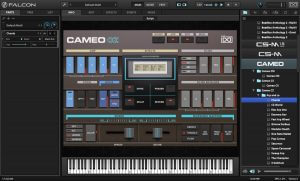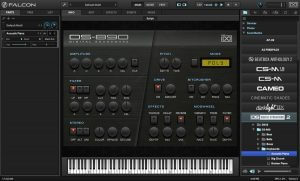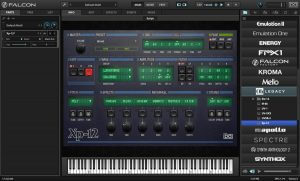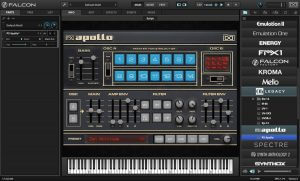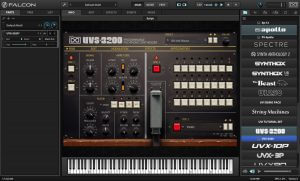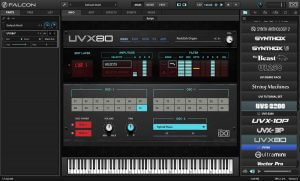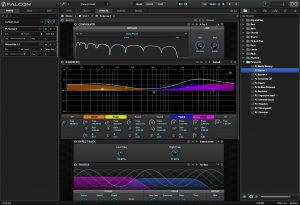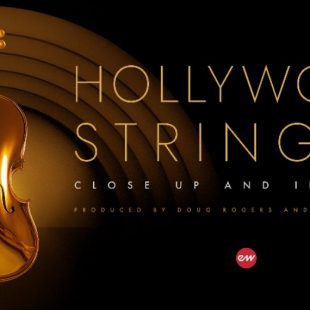UVI Vintage Vault 2 – Retro Rocket
UVI has recently updated the already awesome Vintage Vault Rompler series to an even more action-packed v2. We were wondering how they possibly hope to surpass the original, let’s jump right in and have a play.
(Review updated November 2021) Vintage Vault 2 builds on an already impressive catalogue of synthesis history, introducing 14 brand new synths and 31(!!) new drum machines to the collection. Utilizing the excellent UVI Engine in UVI Workstation or Falcon (check our full reviews), UVI Vintage Vault 2 allows you to pick and choose your instruments to download – or grab them all.
Even though this is a massive collection of instruments weighing in at over 116GB, you receive a single-user license for the entire collection, so download what you like, your collection can grow or shrink as your needs arise. You can drag and drop a new device into your UVI install directory and you’re good to go. The software will detect the new instrument and present it to the player to use. Likewise, if you find you need the hard drive space, you can simply delete a device you’re not using much to save space. The license allows for installation on three separate devices too, so your studio desktop, second writing PC and mobile laptop can all share the same software. A very flexible system indeed.
Globally all the synths share the same basic structure (as most UVI synths do) and you will see familiar FX, LFO, arps and filters on all the instrument patches. It’s a brilliant way to deliver so many instrument varieties, yet provide an easy-to-learn method for controlling them all.
All of the ‘synths’ included are technically romplers, in that the presets load pre-recorded sample programs you can’t directly change like you would with an oscillator. This means each instrument only has a limited number of patches, somewhat of a ‘best of’ selection taken from the real machines. While there are no oscillators to generate new synth tones, included are some clever synthesis controls which give you the perception of real synthesis. Each patch typically has ADSR, amp and filter envelopes, LFOs and modulation effects and even secondary oscillators are applied to excellent results. UVI further enhance the raw samples with proprietary tailored FXs for each preset, usually featuring drive, delay, reverb, chorus, phasing and stereo-widening effects. This combination of synthesis layering and contemporary effect processing takes the original instrument samples to a totally new level, often far beyond what the instrument was ever capable of back in the day.
So synth purists might be a little disappointed at the limited access to the basic algorithmic building blocks available from other synth emulation collections, like Alturia’s V Collection, but the big trade-off is the extremely small learning curve and fast access to very modern-sounding patches. UVI has gone to great pains to retain the gritty ‘analogness’ of these instruments, keeping the noise, floaty tuning and drive the original instruments have – though what will be immediately apparent when you first fire up any of the instruments is the 3D-like width of the patches, particularly the animated arpeggio’s, pads and atmospheres. Since these are samples, not emulations – everything sounds warm with loads of character and vibe right out of the box. There are a lot of post effects added to presets, however, UVI often includes a specially curated selection of original factory patches for you to build your own creations with.
Road Test
Let’s look a little closer at the new instruments included with the collection (our full review of Beatbox Anthology 2 can be found right here)
Cameo
From the 1980’s Casio CZ range – CZ1, CZ101, CZ1000, CZ2300S, CZ3000 and CZ5000, UVI have used these fully restored keyboards to create the three Cameo CX, CZ and CM derivatives. I don’t ever remember my Casio keyboards sounding this lush and warm back in the day, they were always rather thin and weak sounding from my memory – when bits weren’t breaking off the junky plastic fascia that was. I don’t think much has changed over time, they are still considered cheap beginners keyboards. However, what UVI have done here is layer their excellent processing engine to the samples – no more having to deal with dodgy output jacks and key velocity differences, everything sounds amazing.
So the three Casio synths included are not direct replicas of any individual instrument, more a ‘best-bits’ collection split three ways. There is a certain distinctive Casio plonkyness to the patches that they were well known for, but with the clever UVI post-processing, everything sounds lush and wide. All of the patches have very overhyped bass, a lot fatter than any Casio I’ve ever heard.
Overall excellent looking interfaces, as per the rest of the Vintage Vault instruments, though the weird use of buttons instead of knobs is strange (you rub your mouse cursor over the button to affect it, unlike turning a knob), it does keep the style in keeping with the original unit.
All of the patches are great and very usable in contemporary arrangements, though there is a distinct 80’s vibe. I identified a lot with the Cameo because I used a few of the Casio’s sampled here back in the day, unlike the other mega-rare and expensive synths in the collection, Casio’s were in every band rehearsal room around the country. They were the working musicians Jupiter8.
Overall very nicely sampled synth collection with the excellent use of modern processing to create a very useable sound.
Digital Synsations 2
The DK5s is a sampled Kawai K5000, which was one of the more successful PCM-sampled instruments so the ’90s. I had an opportunity to buy one new but decided on the Kurzweil K2500 – mostly for the piano tone, but I never really felt the keyboard delivered anywhere near the same level of synthesis as the Kawai. Fortunately, I get a chance now to play with a great selection of presets from the original machine in software form, and mostly the patches sound brilliant. Of the three instruments in the Digital Sensations 2 collection, I think it’s overshadowed by the others in terms of character, but there’s a lot here to explore.
DS-890, however, is pretty much brilliant in every way. Recorded from the Roland ugly-duckling JD-800, in typical Roland fashion, the basses are huge. Bells are very familiar sounding, surely used in many tracks in the 90s. Mostly you would load this for the pads and bell patches, but there are a bunch of excellent go-to patches, like the Big Church organ and most of the lead patches.
The Dzmo is a little unusual, taken from Ensoniq’s Fizmo – a synth I have never heard of. It’s largely the same style as the DS-890, but with more emphasis on FX, sweeps and weirdo atmospheres. I quite like the overall sound and the lead patches are amazing, most being very usable. The pads are love or hate, but they are defiantly unique.
All three synths sound similar and could have been curated together as one giant bank and you’d be none-the-wiser. I think the original Digital Synsations 1 was more successful in regard to variation, but this is still a great addition to the overall Vault collection.
Ob Legacy
A collection of 1400+ patches from the XP-12, M-6K, UV-XXX, SIX-12, UV-1 and UVSR-2
I’ve owned an Oberheim Matrix 1000 synth in the past, having loved the lush, unique unison detuned sound – so of course, I gravitated to these patches immediately. Though a fair amount of FX processing has been layered over the presets, the original sound is definitely there – in spades. I recognized many of the preset sounds, mostly they sounded as if I had the keyboard right in front of me. There are a bunch of excellent custom-designed patches, plus a good number of the original ones I can remember.
The Ob Legacy banks are collectively more sophisticated than many of the other synths in the Vault. There’s the famous Oberheim signature tone over everything, which is brilliant they have managed to capture. As with my rack-mounted Matrix, these banks require time to explore and feel out.
PX Apollo
Sampled from the ultra-rare Apollo version of the Moog Polymoog Keyboard, this is definitely one of the more interesting synths of the bunch. Since the original instrument was a preset player (it had no filers or oscillators you could program), it works perfectly within the UVI system. They have included the original bass controls, which when engages split the keyboard and added a low bass tone so you could accompany yourself. UVI has added a second oscillator B that was not on the original machine but makes total sense otherwise you would be limited to only the original 14 tones that came with it.
I’m not familiar at all with the Polymoog, but there is a stereotypical “Moogness” about the instrument. It’s not as creamy as the Mini, but it has a distinctive vibe that I’m sure carries through from the original device. I’m immediately reminded of all the corny 70’s action TV show themes, like Space 1999, Six Million Dollar Man and Logan’s Run. Super fun synth, and a definite highlight of the Vault collection.
UVS-3200
Recorded from a Korg PS-3200, again UVI has done an outstanding job capturing the sound and aesthetics of the original device well. Though I’m not a huge Korg fan, especially the early synths like this, UVI’s adds plentiful use of effects take the rather vanilla raw tones to another world. Most of the factory presets do little for me, but once you get into the UVI curated selections then the device comes to life.
The UVS-3200 is the grungy pick of the bunch, especially when a touch of the drive is added to enhance the analogue nastiness. Some of the patches retain the slight detune that made analogue so interesting, rather more predictable than a real synth due to the sampling process, but nonetheless, there and fun to play with. As typical of the early Korg synths, the UVS-3200 is a real bruiser, aggressive and hot-tempered.
Though this is one of the more unique synths in the collection it doesn’t really stand out as being particularly amazing at anything to me other than dirty leads, but then again sometimes all you need is a solid lead, this should be your starting point.
UVX80
Of the new instruments in the Vault collection, this is my favourite synth out of the box. Sampled from the Akai AX80, a mega-rare and valuable synth these days, the internal factory presets are amazing and clearly show why collectors are willing to shell out serious money for the hardware. UVI’s layered processing just brings this instrument to life and delivers for me the best marriage of the two. I could not find a preset that sounded average, though in general, the animated arps showcase the instrument well.
To me, this is very similar sounding to my Juno 106, with a bit more digital clarity I guess. It doesn’t quite have the same analogue brassiness, but Im guessing there was a fair amount of Roland influence on the sound back in the day.
In the Studio
For the most part, the CPU performance was excellent, hovering around 3-6%, depending on the patch. The Apollo chewed a little more sitting around 12% for a single instance, which is not high for a VSTi, but nearly double anything else in the Vault collection. Weirdly, I couldn’t get more than five standard instruments running at once in a single Falcon instance without the DSP engine choking, even though the DAW performance meter never went higher than around 30%.
This is a sizable library at 116GB fully installed, so perhaps a good time to consider that new SSD drive, an expense you’ll want to factor in. Though it’s still great value considering the number of instruments you get, at $600 USD it’s still a sizable chunk of cash as well. Even though you’d pay over $2500 to buy each individually, if you’re not going to fully utilize each and every one of the included instruments you might find just buying 2 or 3 individual synths to get started with.
The big question probably is – do you want a rompler or an emulator? For ease and great sounds out of the box, UVI Vintage Vault 2 is the clear winner and way to go, for realistic synth control you might want to check out Arturia’s offerings, just be prepared for a massive learning curve for each of the included instruments. For Falcon users, the extended synthesis and FX options available further enhance the sampled Vault instruments with your own oscillators and filters to tailor your own massive custom synth banks.
Conclusion
A serious collection of historic synthesizers packaged into an easy-to-use and flexible package. Though the hyper sound patches are capable of being brought back closer to the original recordings, you don’t have the full hands-on synthesis control of a true emulator. Is that important? Not so much for me, as I prefer to make music than twiddle with oscillator tunings.
The Vintage Vault series has been expanded, updated and but still remains excellent value, and if the trend continues to introduce more titles to the line the future looks bright for synthoholics like me. UVI is proving itself time and again as a worthy competition to the venerable Kontakt line, and with its generous licensing, extensive product range and straightforward workflow the UVI Engine platform looks to be the most exciting contender for No1 spot on the market right now.
Full details and purchasing information can be found on UVI’s website right here www.UVI.net

Like the review? Shout us a cup of coffee!

